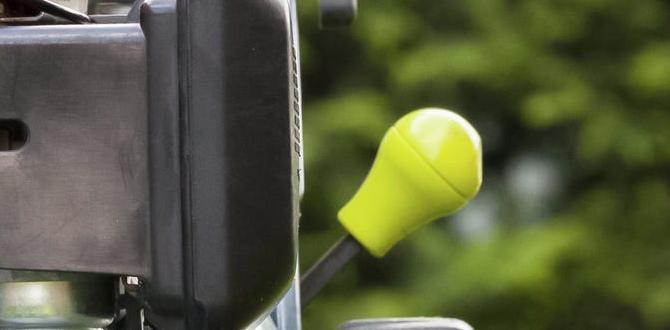Quick Summary: Master using nailers on softwood effortlessly by selecting the right nail gun for your task, using correct pressure settings, ensuring proper nail depth, and always prioritizing safety. Follow these best practices to achieve strong, clean joints every time.
Working with softwood is a common and rewarding part of many DIY projects. Whether you’re building a simple bookshelf, framing a garden planter, or even tackling a small deck, softwood is forgiving and easy to handle. But driving nails can sometimes feel more like a battle than a breeze, especially if you’re new to using nail guns. Missed shots, bent nails, or wood that splits can be incredibly frustrating. Don’t worry, though! With a few key techniques and a little know-how, you can make using nailers on softwood not only easy but incredibly efficient. We’ll walk you through the best practices, from choosing the right tool to finishing the job with confidence. Get ready to make your woodworking projects smoother and faster than ever before!
Table of Contents
Why Softwood Can Be Tricky (and How to Conquer It!)
Softwood lumber, like pine, fir, and cedar, is popular for DIY projects because it’s readily available, affordable, and relatively easy to cut and shape. However, its ‘soft’ nature also means it can be susceptible to damage from tools. When using a nailer on softwood, there are a few common issues beginners face:
Dent marks and surface damage: The nail gun’s nose can leave marks if not used properly.
Nail blow-through on thin pieces: The nail can go all the way through, or even split the wood, particularly on edges or thin stock.
Under-driven or over-driven nails: Nails that aren’t set flush can snag or proud nails can look unsightly and be a hazard.
Workpiece movement: If the nail gun isn’t held firmly, the kickback can move your workpiece, leading to inaccurate placement.
Learning the best practices for using nailers on softwood addresses all these challenges head-on. It’s about understanding your tool and the material. We’re going to cover everything you need to know to achieve clean, strong results without damaging your beautiful softwood.
Choosing the Right Nailer for Softwood Projects
Not all nail guns are created equal, and the type you choose makes a big difference when working with softer woods. For general softwood projects, you’ll usually be choosing between a few common types.
Common Softwood Nailer Types
Brad Nailers: These use thin, headless or small-headed nails (18-gauge or 16-gauge). They are perfect for trim, molding, and attaching thin pieces where a minimal hole and holding power are needed. They don’t offer significant structural strength but are excellent for detail work on softwood.
Finish Nailers: Similar to brad nailers but use slightly thicker nails (16-gauge or 15-gauge) with a small head. These are fantastic for attaching larger trim, window casings, and lighter structural elements where a visible nail head is acceptable or can be easily filled. They provide more holding power than brad nailers.
Framing Nailers: These are heavy-duty tools designed for structural framing. They use much larger nails (typically 2-inch to 3.5-inch) and deliver a lot of power. While overkill for most fine woodworking projects on softwood, they are essential for framing walls, decks, or larger outdoor structures. You’ll need to be extra careful with pressure and depth settings when using these on softer woods.
Pro Tip: For most general DIY projects involving softwood, like building cabinets, shelves, or trim work, an 18-gauge brad nailer or a 16-gauge finish nailer will be your workhorses.
Corded vs. Cordless vs. Pneumatic Nailers
Pneumatic (Air-Powered) Nailers: These are the traditional workhorses. They connect to an air compressor via a hose. They are powerful, reliable, and often the most cost-effective upfront if you already own a compressor. However, the hose can be a bit cumbersome.
Cordless (Battery-Powered) Nailers: These offer ultimate portability. They use battery packs to power a motor that drives the nail. Many modern cordless nailers are surprisingly powerful and eliminate the need for a compressor or power cord, making them very convenient.
Electric (Plug-in) Nailers: Less common for larger tasks, these plug directly into a wall outlet and use a motor to drive the nail. They are good for light-duty projects but lack the power and portability of other types.
For softwood projects, especially if you’re moving around a lot, a cordless nailer can be a game-changer. If you’re doing a lot of framing, a pneumatic framing nailer is usually the way to go due to its power and consistent performance.
Essential Tools and Safety Gear
Before you even pick up a nailer, make sure you have these essentials:
Your Chosen Nailer: Make sure it’s appropriate for the task.
Nails: Use the correct size and type of nails recommended for your specific nailer. Always check the nailer’s manual.
Air Compressor and Hose (if using pneumatic): Ensure it’s the correct PSI for your nailer.
Power Source: Fully charged battery for cordless, or a reliable extension cord for electric.
Safety Glasses or Goggles: This is non-negotiable. Always wear eye protection.
Hearing Protection: Nail guns can be loud, especially framing nailers.
Work Gloves: Protect your hands from splinters and provide a better grip.
Measuring Tape and Pencil: For marking your nailing points.
Clamps: To hold pieces securely in place.
Wood Glue: For stronger joints, always use glue in addition to nails.
Optional Depth Adjustment Tool: Many nailers have this built-in.
Step-by-Step Guide: Mastering Nailer Usage on Softwood
Now, let’s get down to the practical steps for using your nailer effectively on softwood.
Step 1: Understand Your Nailer and Nails
Always read your nailer’s manual. It provides specific instructions for your model, including the types and lengths of nails it accepts, recommended air pressure (for pneumatic), and safety features. Using the wrong nails (e.g., too long, too thick) is a primary cause of problems. For softwood, slightly shorter or thinner nails can sometimes prevent splitting, especially on edges.
Step 2: Connect and Prepare
Pneumatic: Connect the air hose securely to the nailer and your compressor. Set your compressor to the recommended PSI for your nailer. Most nailer manufacturers provide a pressure range for different nail sizes and wood types. For softwood, you’ll often want to operate at the lower end of the recommended PSI range.
Cordless/Electric: Ensure your battery is fully charged or you have a safe power source and extension cord.
Step 3: Load the Nails
Open the magazine (the part that holds the nails) according to your nailer’s instructions. Insert the correct type and length of nails. Make sure they are seated properly and the magazine closes securely. Never dry-fire a nailer (firing it without nails loaded), as this can damage the tool.
Step 4: Set Up Your Workspace & Workpiece
Safety First: Put on your safety glasses and hearing protection.
Secure Your Work: Clamp your workpiece firmly to a workbench or sawhorses. This prevents movement when you fire the nailer, leading to much better accuracy and a cleaner finish.
Position the Nailer: For surface nailing, ensure the nose of the nailer is flush against the wood surface. For edge nailing, be extra cautious.
Consider the Grain: If possible, orient your workpiece so that nails are driven into the grain rather than across very wide grain lines, which can cause splitting.
Step 5: Adjust Nail Depth (Crucial for Softwood!)
Most modern nailers have an adjustable depth setting, often a dial or lever near the nose. This is your best friend when working with softwood.
Why it matters: You want your nails to sink just below the surface of the wood, allowing for filling if needed, but not so deep that they blow through the other side or weaken the joint excessively.
How to test: Find a scrap piece of the same softwood you’re using. Set your dial to the shallowest setting and fire a nail. Check the depth. Gradually increase the depth until the nail drives consistently flush or slightly below the surface.
For softwood: You’ll typically want a lighter touch with the depth setting compared to hardwoods. Start conservatively and increase as needed. If you’re using a framing nailer on softwood studs for a non-load-bearing wall, a slightly shallower set can prevent the nail head from tearing through the wood’s surface.
Step 6: The Nailing Technique
Contact Trip vs. Sequential Trip: Most nailers have two firing modes:
Contact Trip (Bump Fire): You hold the trigger down, and each time the nose is bumped against the wood, a nail fires. This is fast but can lead to accidental firing if not careful.
Sequential Trip: You must first press the nose of the nailer against the wood, then pull the trigger to fire a single nail. This is slower but much safer and more precise.
Recommendation for Softwood: For detailed work or when starting out, sequential trip is highly recommended for better control. Once you’re comfortable, you can use contact trip for faster assembly.
Maintain Firm Contact: Press the nosepiece of the nailer firmly against the wood. This ensures good contact and also activates the safety mechanism (contact trip).
Fire the Nail:
For sequential trip: Bump the nose, then pull the trigger.
For contact trip: Hold the trigger down and bump the nose where you want the nail.
Hold Pressure: Keep light pressure on the nailer against the wood for a second after firing. This helps prevent the nail head from mushrooming or the wood from slightly splintering around the exit point.
Step 7: Nail Placement and Spacing
Edge Nailing Caution: Nailing too close to the edge of softwood is a recipe for splitting. If you must nail near an edge, try to:
Use a thinner gauge nailer (brad nailer).
Drive the nail at a slight angle away from the edge.
Pre-drill a small guide hole (though this defeats some of the nailer’s speed advantage).
Apply a thin bead of wood glue – it acts as a lubricant and helps hold the nail securely even if the wood fibers are a bit compressed.
Overlapping Joints: For strong joints, use glue and nails. Apply glue to both surfaces being joined and then drive nails to hold them together while the glue dries.
Spacing: For structural connections, consult a woodworking or building guide for recommended spacing. For shelves and trim, aim for nails every 6-8 inches and a couple near each end.
Step 8: Troubleshooting Common Issues with Softwood
Nail Not Firing: Check power source (battery, air pressure), ensure nails are loaded correctly, and make sure the safety tip is depressed. A jam may occur; refer to your manual for clearing jams safely.
Nail Jammed: Always disconnect power/air source before clearing a jam. Follow your manual’s instructions. Usually, this involves opening the magazine and carefully removing the jammed nail.
Nail Driven Too Deep (Recessed): Increase the depth setting slightly or decrease air pressure (sequential trip users often find slightly less power is better for flush finish).
Nail Proud (Sticking Out): Decrease the depth setting or increase air pressure. Ensure you’re pressing firmly. Sometimes a careful tap with a hammer and nail set can fix a slightly proud nail.
Wood Splitting: This is common with softwood.
Reduce air pressure or lighten depth setting.
Use thinner gauge nails.
Avoid nailing too close to edges.
Pre-drill pilot holes for very critical joints or very brittle softwood.
Apply wood glue; it reinforces the joint.
Best Practices at a Glance for Softwood
Here’s a quick summary of key practices to keep in mind when working with softwood and nailers:
Use the Right Nailer: Brad or finish nailers for trim/cabinetry, framing nailers for structural work.
Use Correct Nails: Match nail gauge and length to your tool and project.
Start with Low Air Pressure/Depth: Especially for pneumatic tools, begin on the lower end of the recommended PSI and adjust. For depth, always test on scrap first.
Always Use Safety Gear: Eye and hearing protection are mandatory.
Firm Workpiece Clamp: Secure your material to prevent movement.
Flush Nosepiece: Ensure the nailer’s nose is flat against the wood.
Sequential Trip for Control: Use this firing mode when precision is key.
Watch the Edges: Be extra careful when nailing near the ends or edges of softwood to prevent splitting.
Glue is Your Friend: Always combine nails with wood glue for superior joint strength.
Test on Scrap: Never skip this step for new projects or after adjusting settings.
Understanding Nail Depth and Air Pressure
The interplay between nail depth adjustment and air pressure (for pneumatic nailers) is critical for successful softwood nailing.
| Setting | Impact on Softwood | Adjustment Strategy |
|---|---|---|
| Nail Depth (Depth Adjustment Dial/Lever) | Determines how far the nail head sinks into the wood. | Too deep: Blow-through, splitting, weak joint. Too shallow: Proud nail head, poor adhesion. |
| Air Pressure (PSI – Pneumatic) | Delivers the force to drive the nail. | Too high: Blow-through, denting, splitting. Too low: Under-driven nail. |
General Rule for Softwood: Err on the side of less power. Start with a depth setting that requires a gentle press and lower PSI on pneumatic tools. You can always increase them if the nail isn’t driving properly. For instance, a typical 16-gauge finish nailer might work well on pine at 70-90 PSI for detailed work, whereas the same nailer on oak might require 90-110 PSI.
For example, if you’re attaching 1/2-inch pine trim to a softwood stud, you want the nail to go through the trim and into the stud firmly, but not so hard that it punches through to the front of the trim or splits the trim. Testing on a scrap piece of your trim material and a scrap piece of your stud material is the best way to find that sweet spot.
You can find excellent resources on tool specifications and safe operating pressures from manufacturers like DEWALT, which offer product manuals detailing optimal settings.
Advanced Tips for Flawless Softwood Projects
Once you’ve got the basics down, here are a few extra tips to elevate your softwood nailing game.
Reinforcing Joints with Glue
This cannot be stressed enough: always use wood glue when joining pieces of softwood, even when using a nailer. Nails are primarily for holding pieces together while the glue dries. Once dry, the glue creates a bond that is significantly stronger than nails alone. Apply a thin, even layer of good quality wood glue to both surfaces. Wipe away any excess glue that squeezes out with a damp cloth before it dries.
Countersinking Nails (When Necessary)
For trim work or projects where you plan to paint or fill nail holes, you want the nail head to be slightly below the surface. Most nailers, when set correctly, will achieve this. If your nailer consistently leaves nails proud, and you can’t adjust it further, or if you’re dealing with particularly hard knots in otherwise soft wood, you might need to gently tap the nail head with a nail set and hammer after firing. This is a manual process that gives you ultimate control.
Using Spackle or Wood Filler
After nailing, especially if you’ve had to set nails slightly below the surface, you’ll want to fill the nail holes for a smooth finish. For painted projects, spackle or lightweight joint compound works wonders. For stained projects, use a good quality wood filler that closely matches your wood’s color. Apply it with a putty knife, let it dry completely, and then sand it smooth.
Frequently Asked Questions (FAQ) about Nailers and Softwood
Q1: Will my nailer split soft wood like pine?
Yes, it’s possible. Softwood is prone to splitting, especially near edges or when nailing through knots. To prevent this: reduce air pressure (pneumatic), use a shallower depth setting, use thinner gauge nails (like 18-gauge if suitable), and avoid nailing too close to the edge.
Q2: What’s the best nail length for softwood trim?
For typical 1/2-inch to 3/4-inch softwood trim attached to 3/4-inch or thicker softwood studs, 1.5-inch to 2-inch nails are usually a good starting point. Always aim for at least 1 inch of penetration into the solid structural piece (the stud or frame) for good holding power.
Q3: Should I use glue with my brad nailer on pine cabinets?
Absolutely! Always use wood glue for



